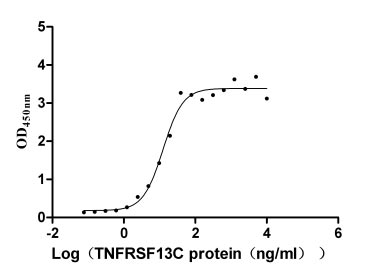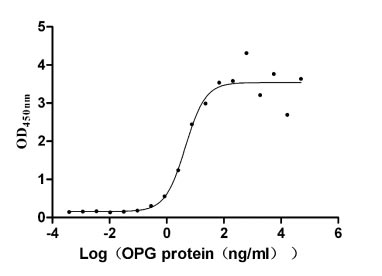Recombinant Human Sialidase-3 (NEU3), partial
In Stock-
中文名称:人NEU3重组蛋白
-
货号:CSB-EP891986HU
-
规格:¥1344
-
图片:
-
其他:
产品详情
-
纯度:Greater than 90% as determined by SDS-PAGE.
-
基因名:NEU3
-
Uniprot No.:
-
别名:NEU3Sialidase-3; EC 3.2.1.18; Ganglioside sialidase; Membrane sialidase; N-acetyl-alpha-neuraminidase 3
-
种属:Homo sapiens (Human)
-
蛋白长度:Partial
-
来源:E.coli
-
分子量:52.1kDa
-
表达区域:2-428aa
-
氨基酸序列EEVTTCSFNSPLFRQEDDRGITYRIPALLYIPPTHTFLAFAEKRSTRRDEDALHLVLRRGLRIGQLVQWGPLKPLMEATLPGHRTMNPCPVWEQKSGCVFLFFICVRGHVTERQQIVSGRNAARLCFIYSQDAGCSWSEVRDLTEEVIGSELKHWATFAVGPGHGIQLQSGRLVIPAYTYYIPSWFFCFQLPCKTRPHSLMIYSDDLGVTWHHGRLIRPMVTVECEVAEVTGRAGHPVLYCSARTPNRCRAEALSTDHGEGFQRLALSRQLCEPPHGCQGSVVSFRPLEIPHRCQDSSSKDAPTIQQSSPGSSLRLEEEAGTPSESWLLYSHPTSRKQRVDLGIYLNQTPLEAACWSRPWILHCGPCGYSDLAALEEEGLFGCLFECGTKQECEQIAFRLFTHREILSHLQGDCTSPGRNPSQFKSN
Note: The complete sequence including tag sequence, target protein sequence and linker sequence could be provided upon request. -
蛋白标签:N-terminal 6xHis-tagged
-
产品提供形式:Liquid or Lyophilized powder
Note: We will preferentially ship the format that we have in stock, however, if you have any special requirement for the format, please remark your requirement when placing the order, we will prepare according to your demand. -
缓冲液:Tris-based buffer,50% glycerol
-
储存条件:Store at -20°C/-80°C upon receipt, aliquoting is necessary for mutiple use. Avoid repeated freeze-thaw cycles.
-
保质期:The shelf life is related to many factors, storage state, buffer ingredients, storage temperature and the stability of the protein itself.
Generally, the shelf life of liquid form is 6 months at -20°C/-80°C. The shelf life of lyophilized form is 12 months at -20°C/-80°C. -
货期:3-7 business days
-
注意事项:Repeated freezing and thawing is not recommended. Store working aliquots at 4°C for up to one week.
-
Datasheet & COA:Please contact us to get it.
相关产品
靶点详情
-
功能:Exo-alpha-sialidase that catalyzes the hydrolytic cleavage of the terminal sialic acid (N-acetylneuraminic acid, Neu5Ac) of a glycan moiety in the catabolism of glycolipids, glycoproteins and oligosacharides. Displays high catalytic efficiency for gangliosides including alpha-(2->3)-sialylated GD1a and GM3 and alpha-(2->8)-sialylated GD3. Plays a role in the regulation of transmembrane signaling through the modulation of ganglioside content of the lipid bilayer and by direct interaction with signaling receptors, such as EGFR. Desialylates EGFR and activates downstream signaling in proliferating cells. Contributes to clathrin-mediated endocytosis by regulating sorting of endocytosed receptors to early and recycling endosomes.
-
基因功能参考文献:
- This first demonstration of sialidase involvement in invasive potential of gliolastoma cells may point to NEU3 as an attractive treatment target of human gliomas PMID: 28760640
- effect of overexpression on EGFR downstream pathway activation and TKI targeted therapies sensitivity in non-small cell lung cancer cell lines PMID: 29088281
- The most potent compound tested targeted the human Neu4 isoenzyme, and was able to substantially reduce the rate of cell migration. We found that the lateral mobility of integrins was reduced by treatment of cells with Neu3, suggesting that Neu3 enzyme activity resulted in changes to integrin-co-receptor or integrin-cytoskeleton interactions PMID: 27344026
- NEU3 possesses the ability to interact with specific proteins, many of which are different in each cell compartment, supporting NEU3 involvement in the cell stress response, protein folding, and intracellular trafficking. PMID: 26987901
- findings identify NEU3 as a participant in head and neck squamous cell carcinoma progression PMID: 26470851
- Besides the already reported indirect EGFR activation through GM3, sialidase NEU3 could also play a role on EGFR activation through its desialylation. PMID: 25922362
- NEU3 promotes anchorage-independent growth and in vivo tumorigenicity. PMID: 25803810
- In the plasma membrane, NEU3 has a role in endocytosis and protein binding at the cell surface. PMID: 26251452
- Results indicate an essential contribution of NEU3 to tumorigenic potential through maintenance of stem-like characteristics of colon cancer cells by regulating Wnt signaling at the receptor level. PMID: 25810027
- The results provide strong evidence that the serum sialidase is, in fact, NEU3, and this subtype may, therefore, be a potential utility for novel diagnosis of human cancers PMID: 25652216
- Studies indicate that ganglioside-specific sialidase NEU3 cleaves sialic acids preferentially from gangliosides. PMID: 25408341
- Weak anchorage of NEU1 and NEU3 to the plasma membrane and their loss during erythrocyte life could be a tool to preserve the cellular sialic acid content to avoid early aging of erythrocyte and processes of cell aggregation in the capillaries. PMID: 22903576
- NEU3 is a key regulator of the beta1 integrin-recycling pathway and FAK/AKT signaling and demonstrate its crucial role in renal cell carcinomas malignancy. PMID: 23139422
- Data indicate that sialidases Neu1 and Neu3 are present on sperm, and their activity is required for capacitation and zona pellucida binding. PMID: 22989879
- Data show that NEU1 was immunolocalized to both the plasma membrane and the perinuclear region, and NEU3 was detected both in the cytosol and nucleus. PMID: 22403397
- These data suggest that NEU3 regulates tumor progression through AR signaling, and thus be a potential tool for diagnosis and therapy of androgen-independent prostate cancer. PMID: 21681193
- NEU3 is highly expressed to enhance malignant phenotypes including apoptosis inhibition in malignant melanomas. PMID: 21895867
- observed that trisaccharides with incorporated azide groups in the Neu5Ac residue at either C9 or the N5-Ac position were substrates, and in the case of the N5-azidoacetyl derivative, the activity was superior to that of GM3 PMID: 21675735
- Truncations at the N- or C-terminus of more than 10 residues abolished enzyme activity. PMID: 20511247
- NEU3 expression is diversely regulated by Sp1/Sp3 transcription factors binding to alternative promoters, which might account for multiple modulation of gene expression. PMID: 20518744
- Data show that Neu3 could represent a new potent biomarker in childhood ALL, to assess the efficacy of therapeutic protocols and to rapidly identify an eventual relapse. PMID: 19588508
- Neu3 functions as a caveolin-related signaling molecule within caveolin-rich microdomains PMID: 12011038
- up-regulation of plasma membrane-associated ganglioside sialidase (Neu3) in human colon cancer and its involvement in apoptosis suppression PMID: 12149448
- NEU3 participates in the control of insulin signaling via modulation of gangliosides and interaction with Grb2 PMID: 12730204
- Results show that the sialidase activity of human membrane type ganglioside sialidase (Neu3)is specific for gangliosides. PMID: 15179041
- Data show that the differentiation of monocytes into macrophages is associated with regulation of the expression of at least three distinct cellular sialidases, Neu1, 3, and 4, with specific up-regulation of the enzyme activity of only Neu1. PMID: 15885103
- NEU3 differentially regulates cell proliferation through integrin-mediated signalling depending on the extracellular matrix and, on laminins, NEU3 activated molecules often up-regulated in carcinogenesis. PMID: 16241905
- NEU3 activated by IL-6 exerts IL-6-mediated signaling, largely via the PI3K/Akt cascade, in a positive feedback manner and contributes to expression of a malignant phenotype in renal cell carcinoma PMID: 16428383
- NEU3 is able to mobilize to membrane ruffles in response to growth stimuli and activate the Rac-1 signaling by co-localization with Rac-1, leading to increased cell motility. PMID: 16765317
- The activity of Neu3 changed minimally in activated lymphocytes. PMID: 17028199
- NEU3 is an important regulator of insulin sensitivity and glucose tolerance. PMID: 17292733
- NEU3 may be an essential gene for cancer cell survival. PMID: 17334392
- Neu3 is up-regulated in Jurkat cells undergoing etoposide-induced apoptosis PMID: 17827720
- NEU3 is markedly up-regulated in many types of cancers including colon and renal carcinomas and suppresses apoptosis of cancer cells. PMID: 18023981
- Neu3 degrades membrane sialic acids resulting in downregulation of the PKC/ERKs/p38 MAPK signaling pathway, causing a decrease in CD41b surface antigen expression and inhibition of megakaryocytic differentiation of K562 cells. PMID: 18339327
- related to malignancy and may be potential targets for cancer diagnosis and therapy PMID: 18651674
- upon Neu3 silencing, K562 cells show a decrease in proliferation, propensity to undergo apoptosis, and megakaryocytic differentiation. PMID: 18820643
- increased CD15 expression is not due to de novo biosynthesis of CD15, but results predominantly from induction of alpha(2-3)-sialidase activity PMID: 18953356
- occurrence of Neu3 in the inner membrane and Neu1 in the outer membrane of the nuclear envelope PMID: 19686243
显示更多
收起更多
-
亚细胞定位:Cell membrane; Peripheral membrane protein. Membrane, caveola. Early endosome membrane; Peripheral membrane protein. Recycling endosome membrane; Peripheral membrane protein. Lysosome membrane; Peripheral membrane protein.
-
蛋白家族:Glycosyl hydrolase 33 family
-
组织特异性:Highly expressed in skeletal muscle, testis, adrenal gland and thymus, followed by pancreas, liver, heart and thymus. Weakly expressed in kidney, placenta, brain and lung.
-
数据库链接:
HGNC: 7760
OMIM: 604617
KEGG: hsa:10825
STRING: 9606.ENSP00000294064
UniGene: Hs.191074
Most popular with customers
-
Express system: Mammalian cell
Species: Homo sapiens (Human)
-
Recombinant Human Tumor necrosis factor receptor superfamily member 11B (TNFRSF11B) (Active)
Express system: Mammalian cell
Species: Homo sapiens (Human)
-
Recombinant Human Carcinoembryonic antigen-related cell adhesion molecule 6 (CEACAM6) (Active)
Express system: Mammalian cell
Species: Homo sapiens (Human)
-
Recombinant Human Cell adhesion molecule 1 (CADM1), partial (Active)
Express system: Mammalian cell
Species: Homo sapiens (Human)
-
Recombinant Human Interleukin-2 receptor subunit alpha (IL2RA), partial (Active)
Express system: Mammalian cell
Species: Homo sapiens (Human)


















